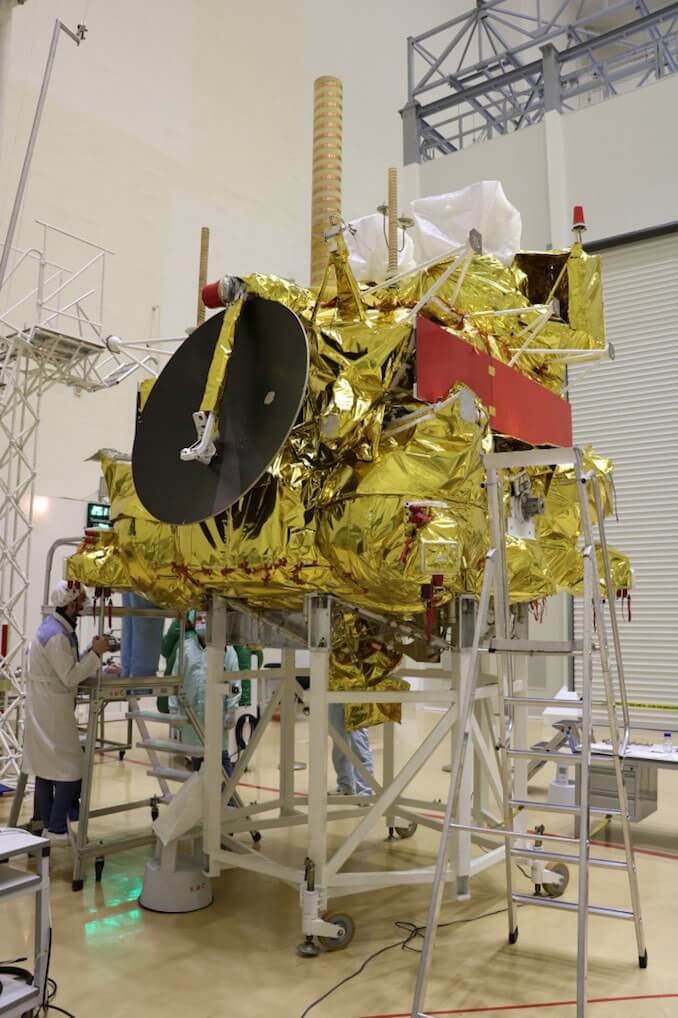Russia launched a Soyuz rocket Sunday through a veil of fog over the Baikonur Cosmodrome in Kazakhstan, carrying the first spacecraft in a new program to monitor Arctic weather systems and relay emergency communications.
The Soyuz-2.1b rocket lifted off from the Site 31 launch pad at Baikonur at 1:55:01 a.m. EST (0655:01 GMT; 11:55:01 a.m. local time) and quickly disappeared into a shroud of fog hanging over the frozen steppes of Kazakhstan.
The rocket’s kerosene-fueled engines generated nearly a million pounds of thrust to climb off the launch pad. The Soyuz headed northeast from Baikonur and dropped its four first stage boosters around two minutes after liftoff. The rocket’s second stage, or core stage, continued firing until just shy of the mission’s five-minute mark. The Soyuz payload fairing jettisoned after the rocket climbs above the dense, lower layers of the atmosphere.
A third stage powered by an RD-0124 engine ignited to accelerate the Arktika-M 1 satellite and a Fregat upper stage to near orbital velocity.
The Fregat upper stage with Arktika-M 1 separated from the Soyuz third stage at T+plus 9 minutes, 23 seconds, followed soon by the first burn by the Fregat’s main engine to reach a preliminary parking orbit. Two more Fregat engine firings were expected to boost the Arktika-M 1 spacecraft into a highly elliptical, or oval-shaped, orbit ranging between about 600 miles and 25,000 miles (1,050 and 39,800 kilometers).
The 4,850-pound (2,200-kilogram) Arktika-M 1 satellite was scheduled to deploy from the Fregat space tug at 4:14 a.m. EST (0914 GMT), about 2 hours, 19 minutes, after liftoff.
Roscosmos, the Russian space agency, confirmed the Arktika-M 1 satellite separated from its launch vehicle in an on-target orbit. Dmitry Rogozin, head of Roscosmos, tweeted that the satellite’s solar panels opened as planned, and ground teams established communications with the spacecraft.
“All good!” Rogozin tweeted.
The Soyuz launch Sunday occurred in conditions that were at the “very limit” of the rocket’s weather constraints, according to Rogozin. The winds up to an altitude of 2 kilometers were particularly strong, Rogozin tweeted.
“But the rocket and its control system coped brilliantly,” he wrote.
In its elongated path around Earth — also called a Molniya-type orbit — the Arktika-M 1 spacecraft will take about 12 hours to complete one lap around the planet.
The satellite’s orbit has an inclination of about 63.3 degrees, meaning Arktika-M 1 will linger above the northern hemisphere when it farthest from Earth, providing its instruments a view of Arctic weather patterns for multiple hours on each orbit. With two satellites in orbits positioned 180 degrees apart, the Arktika network could provide around-the-clock coverage over the Arctic.
Arktika-M 1 is the first of a new line of satellites designed to provide persistent weather data on Russia’s Arctic, home to economically lucrative natural resources, energy reserves, and an important region for Russian military operations. The Arktika-M satellites are built by NPO Lavochkin, the same Russian company that builds Fregat upper stages.
The Arktika-M 1 satellite is based on the design of Russia’s Elektro-L weather satellites that fly in geostationary orbit over the equator. Weather observatories in geostationary orbit collect imagery 24 hours a day over the same part of the Earth, but they are unable to peer at weather systems over high latitude regions.
According to Roscosmos, Russia’s space agency, the Arktika-M satellites will obtain color images of clouds and Earth’s surface in the Arctic. The Arktika-M satellites also host radio receivers and transmitters to relay information from weather stations and search-and-rescue beacons in polar regions, which are inaccessible to conventional geostationary satellites.
In addition to weather observations and emergency communications support, the Arktika-M satellites will help forecast solar flare activity, measure radiation through the Van Allen belts, and collect data on Earth’s magnetosphere and ionosphere, Roscosmos said.
Roscosmos said engineers modified the spacecraft design used for Russia’s Elektro-L weather satellites to make it suitable for the Arktika program. The changes include additional radiation hardening and solar batteries to meet the challenges of the elliptical Molniya orbit.
Email the author.
Follow Stephen Clark on Twitter: @StephenClark1.
– Advertisement –
